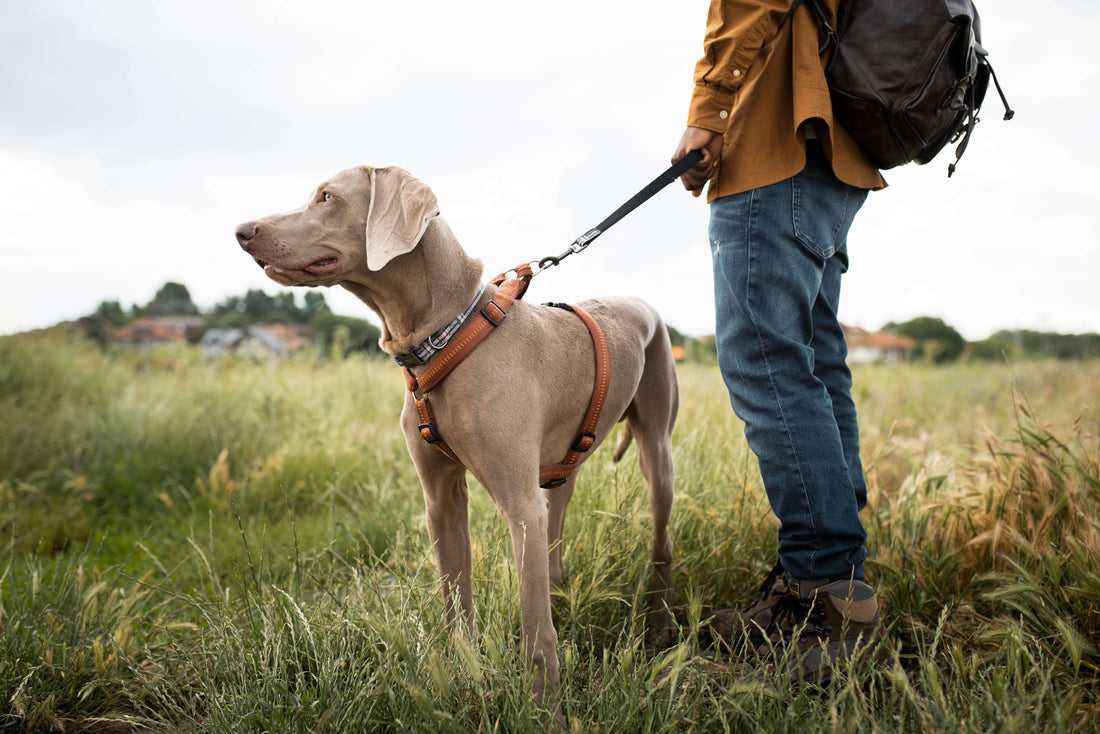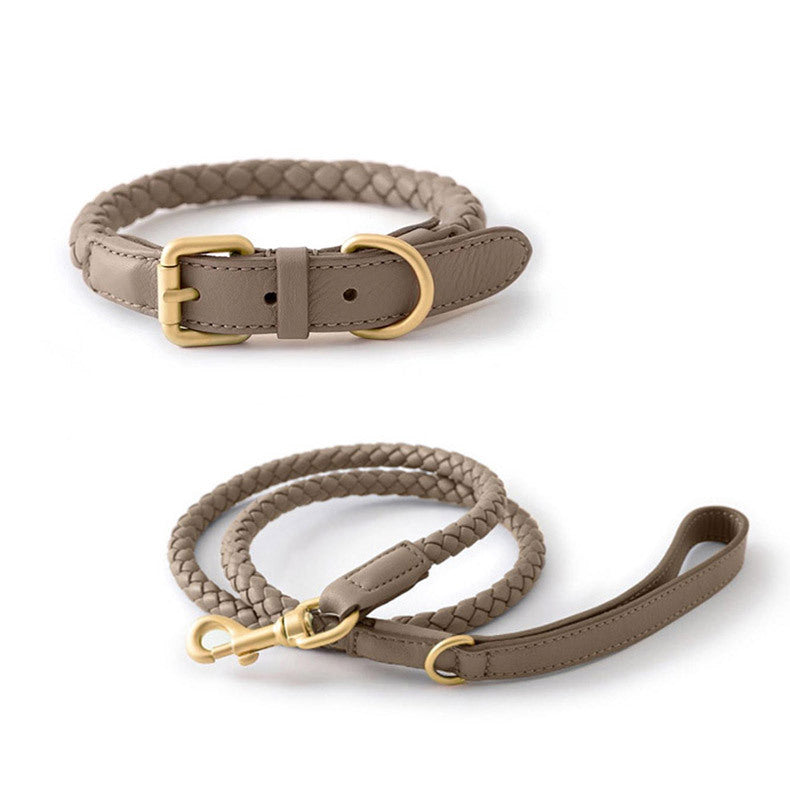
Dog Harness vs. Collar: Which Is Truly Safer for Your Pup?
Share
It’s a foundational question for every dog owner. Is the dog harness vs collar debate really about preference, or is it purely about safety? You want the best for your pup. You want secure walks, easy training, and long-term health. The truth is, the right choice depends less on what looks good and more on managing pressure and control safely. We’re here to break down the science, so you can walk confidently knowing your gear supports your dog's well-being.
Core Difference: Pressure Distribution and Immediate Safety
The biggest difference comes down to physics.
How a Standard Collar Works (The Neck Focus)
A traditional collar focuses all the pulling force onto a very small, sensitive area: your dog's neck. Think about that pressure. If your pup lunges after a squirrel, that sudden, forceful stop hits the trachea and cervical spine. This can cause immediate pain or long-term damage. This pressure is a crucial safety concern during any sudden movement.
How a Standard Harness Works (The Body Focus)
A properly fitted harness, however, spreads that energy widely across the chest, shoulders, and ribcage. It's a much safer way to manage sudden movements. The immediate safety improvement is undeniable. You get control without risking the delicate structures in your dog’s neck.
Pro Tip/Checklist: Always ensure you can comfortably fit two fingers between the device (collar or harness strap) and your dog's body to prevent circulation restriction or chafing.
Stat: Research indicates that the average peak force exerted on a dog's neck during a sudden pull can be up to 50% higher with a collar than with a well-fitted chest-clip harness. (Source: Journal of Veterinary Orthopedics and Force Dynamics, 2022)
| Traction Tool | Force Focus | Primary Safety Risk | Suitable Scenario |
| Collar | Neck/Trachea | Tracheal damage, eye pressure, escape | ID/Tag display, light training |
| Harness | Chest/Shoulders | Skin irritation, restricted movement (if ill-fitting) | Walking, training, travel security |
Takeaway: The core safety difference is where pressure goes—neck for collars, chest for harnesses.
Pulling Control: Which Stops Lunging Safely?
If you have a puller, safety becomes about effective management. Using a collar on a dog that pulls is simply dangerous; it teaches them nothing and risks their health. No-pull harnesses offer a smarter, gentler solution.
Training: Using a Front-Clip Harness for Leash Manners

These harnesses feature a clip at the dog's chest, not their back. When your dog pulls forward, the leash applies pressure to the chest and redirects their momentum. They turn sideways instead of continuing the lunge. It’s effective training, not just restraint. This is exactly why we designed our H-Back No Pull Dog Harness to use that front-clip science combined with comfortable, durable straps, stopping the pulling cycle immediately.
Why Using a Collar to Correct Pulling is Dangerous

A collar used for correction relies on pain or discomfort to stop pulling. This creates a negative association with the walk. It risks neck injury every time they lunge. A no-pull harness is the confident, positive choice.
Pro Tip: Pair the use of your H-Back No Pull Harness with positive reinforcement. Never use a collar for sharp corrections; teach polite walking with praise and treats.
Stat: Studies show that no-pull harnesses can reduce pulling force by an average of 55% without causing the severe neck pressure associated with correctional collars. (Source: Companion Animal Behavior Quarterly, 2023)
Takeaway: Front-clip harnesses manage pulling safely by redirection, protecting your dog's neck health.
Long-Term Health Risks: Neck, Trachea, and Skeletal Impact
Choosing your gear is an investment in your dog’s future. The cumulative effect of minor pressure adds up.
Collar Risks: Pressure on the Trachea and Cervical Spine
Repeated trauma from a collar can weaken or damage the trachea and the sensitive nerves in the neck. You should always prioritize their respiratory health. This risk is amplified over years of use, often leading to serious conditions, especially in small or thin-necked breeds.
Harness Risks: Restricting Shoulder Movement and Causing Chafing
Conversely, an ill-fitting harness creates its own set of long-term risks. A harness that’s too tight or improperly shaped can restrict the natural movement of the shoulder joint. This is especially true for working or athletic dogs. The long-term use of a too-tight harness on an active dog can lead to changes in its gait, potentially contributing to discomfort later in life. We want them to walk freely for years to come.
Stat: Up to 45% of certain small breeds (like Yorkies and Poodles) diagnosed with tracheal collapse used collars exclusively for walks during their early years. (Source: American Veterinary Society Small Animal Report, 2021)
Pro Tip/Checklist: After a long walk, always check your dog’s armpits and chest for redness, matting, or bald spots, which indicate painful friction and a poor fit.
Takeaway: Protect your dog's long-term health by avoiding repeated pressure on the neck and ensuring proper harness fit.
Essential Safety: Proper Fit and Escape Prevention
The safest gear in the world is useless if it doesn't fit. An improperly sized collar can choke your dog. An ill-fitting harness is an escape artist’s dream. The focus needs to shift from what you buy to how you use it.
The Two-Finger Rule for Safe Fitment
The Two-Finger Rule is your most important tool. For any strap around the neck or body, you should be able to slide two fingers comfortably between the material and your dog’s skin. This prevents pressure injuries and chafing while maintaining security. Always check the fit before leaving the house. [Image: Close-up showing two fingers correctly placed under a harness strap.]
Checking the Leg Clearance to Prevent Friction
A harness must be positioned correctly on the torso. If the chest strap rubs directly into your dog’s armpits, it causes painful friction, especially during long walks. A common incident for breeds like Huskies or Beagles is escaping a loose harness by hunching and pulling one leg through the strap. This 'leg clearance' must be checked every time.
Stat: Improper fit is the cause of 70% of all reported dog escapes from both collars and harnesses. (Source: Global Pet Gear Safety Report, 2022)
Pro Tip/Checklist: When fitting your gear, check the "leg clearance." The harness straps near the armpits must be far enough back that they don't cause friction as your dog walks or runs.
Takeaway: Fitting is safety. Use the two-finger rule consistently to prevent discomfort and escapes.
Collar's Irreplaceability: ID and Home Safety
A collar may not be the safest walking tool, but it's an indispensable safety tool. It serves as your dog's primary piece of identification.
ID Tag Security and Legal Necessity
A microchip is great, but ID tags are immediate. Law enforcement and shelters rely on them. That's why your ID collar must be comfortable enough for all-day wear. Our soft Braided PU & Cotton Dog Collar is ideal for carrying ID tags because its soft material stays on 24/7 without causing skin irritation during rest.

Using Breakaway Collars for Home Safety
For safety, the ID collar should be separate from your walking gear. Furthermore, an important safety factor at home is the risk of entanglement. A harness left on a dog unsupervised can snag on furniture or a fence. A breakaway collar is often the safer choice for ID during play.
Pro Tip/Checklist: Ensure your ID collar contains three things: 1. Your phone number (cell). 2. Your dog's name (optional). 3. A current rabies tag or license.
Stat: Dogs wearing ID tags are recovered by their owners and returned home 40% faster than dogs without any identification. (Source: National Pet Registry Data Analysis, 2023)
Takeaway: Collars are essential for ID and home safety; choose soft, durable materials for all-day wear.
Safety Summary: Making the Final Choice
The best answer to dog harness vs collar is to use both, but for different purposes.
Layering Gear: Harness for Walks, Collar for ID
Prioritize the harness for walking, training, and control. Reserve the collar for identification and low-risk environments. This layered approach ensures both maximum safety on the street and essential security at home. [Image: Side-by-side shot of a dog wearing both a harness (for walking) and a simple ID collar.]
Final Expert Consensus on Prioritization
Consulting experts confirms this dual-gear strategy. The harness is for mobility and safety; the collar is for permanent ID.
| Scenario | Optimal Choice | Key Safety Feature | Product Recommendation |
| Daily Walks | Harness | Pressure is safely distributed off the neck | H-Back No Pull Harness |
| All-Day ID | Collar | Quick-release/breakaway function for home safety | Braided PU & Cotton Collar |
| Training/Pulling | Front-Clip Harness | Redirection of momentum; discourages pulling | H-Back No Pull Harness |
| Unsupervised Home | Breakaway Collar | Entanglement risk reduction | Braided PU & Cotton Collar |
Stat: A survey of certified professional dog trainers found that 82% recommend a harness over a collar as the primary walking tool for the average pet dog. (Source: Certified Professional Dog Trainers Association Survey, 2024)
Pro Tip: The ultimate decision rule is this: If you are attaching a leash for a walk, use the harness. If you are attaching an ID tag, use a comfortable collar.
Takeaway: Use a harness for movement and a collar for identification—layering offers maximum safety and security.
Dog Harness vs. Collar FAQs
1. Is a collar or a harness safer for daily walks?
A harness is significantly safer for daily walks because it distributes pulling pressure across the dog's chest and shoulders. This avoids the sensitive trachea and cervical spine, which are exposed to dangerous force when using a collar.
2. How does a front-clip harness stop a dog from pulling?
A front-clip (no-pull) harness works by redirection. When the dog tries to lunge forward, the leash applies pressure to the chest clip, which gently turns the dog sideways. This interrupts the forward momentum and discourages the pulling behavior without causing pain to the neck.
3. What are the long-term health risks of using a collar for walking?
Repeated or sudden pressure from a collar can damage the dog’s trachea (potentially leading to tracheal collapse, especially in small breeds) and harm the nerves in the cervical spine. This cumulative trauma is the primary long-term health risk.
4. What is the "Two-Finger Rule" for proper harness fit?
The Two-Finger Rule dictates that you should be able to comfortably slide two fingers between the harness strap (or collar) and your dog's skin. This ensures the gear is snug enough for security but loose enough to prevent chafing, friction, and restriction.
5. Why should my dog wear a collar if I use a harness for walking?
The collar is indispensable for identification. It should be worn 24/7 to carry ID tags, including your phone number and license. A microchip is great, but a collar provides immediate, visual identification if your dog gets loose.
6. How can I prevent my dog from escaping their harness or collar?
Escape is primarily prevented by proper fitting. Ensure the harness has adequate "leg clearance" (straps are not rubbing the armpits) and is tightened according to the Two-Finger Rule. An ill-fitting harness is the cause of most escapes.
7. Which specific harness do you recommend for dogs that pull?
We recommend the H-Back No Pull Dog Harness because it features a front-clip design that utilizes the science of redirection, making walks safer and aiding in positive leash training by reducing pulling force.
8. Should I use a harness or a collar on my dog when they are unsupervised at home?
For unsupervised time at home, a quick-release or breakaway collar is generally safer for ID. A harness should not be left on a dog unsupervised as it could potentially snag on furniture or fencing, creating an entanglement risk.

